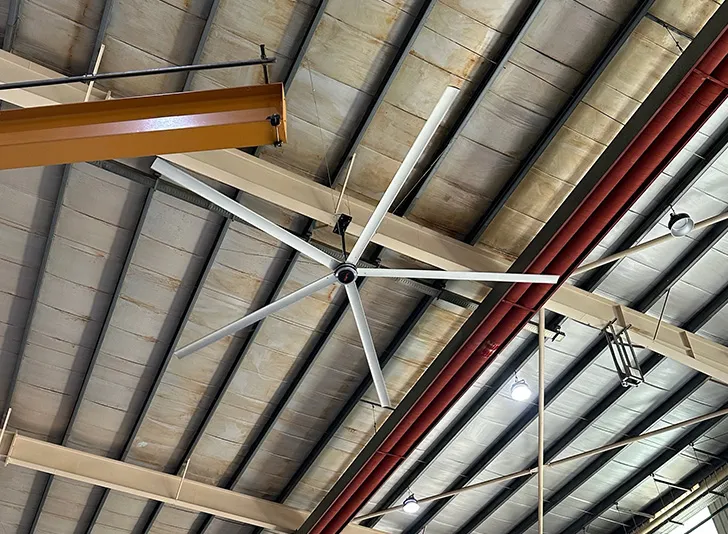When a single ventilador de teto struggles beneath an teto industrial, poor fluxo de ar drives up custos de energia and drives down productivity.
Industrial HVLS ceiling fans are oversized, low-speed, alto volume units that move an impressive quantidade de ar—often hundreds of thousands of cubic feet per minute—across very grandes espaços while using surprisingly little power. They replace clusters of small room fans, reduzir consumo de energia, and keep workers comfortable all year.

Industrial HVLS ceiling fan for warehouse ventilation
High-Volume-Low-Speed (HVLS) technology relies on wide pás do ventilador—often with extruded aluminum blades—rotating at fewer than 100 rpm. That low-speed sweep creates a towering column of movimento do ar that spreads out in a 360° pattern, forcing cool air down and pushing warm air toward vents. One single hvls unit can replace a dozen box fans in espaços industriais.
By moving so much air the fan quickly equalizes temperature, cuts humidity, and produces caudal de ar máximo without drafts. A grande fã like our 7.3 m (24 ft) model covers up to 2 000 m² (over 20 000 metragem quadrada), moving more than 300 000 pés cúbicos per minute (CFM-CFM). That’s true alto volume performance at baixa velocidade.
Factory floors, aircraft hangars, and sports halls are classic sala grande environments. Because hot air stratifies above the working zone, employees feel stuffy while heaters work overtime. Ventiladores de teto industriais break that thermal layer so everybody in great rooms feels the same temperature—no cold shoulders, no sweaty corners.
Ventiladores de teto grandes are rated by CFM-CFM-o quantidade de ar they displace. A 4.3 m (14 ft) fan typically delivers 150 000 cfm, while a 7.3 m (24 ft) unit exceeds 300 000 cfm. That’s 25× the capacity of a 56 cm pedestal powerful fan and equals the airflow of a small rooftop blower—yet draws less than 1 kW.
| Diameter (ft) | CFM típico | Coverage (m²) |
|---|---|---|
| 14 | 150 000 | 900 |
| 18 | 200 000 | 1 200 |
| 24 | 300 000 | 2 000 |
Um eficiente em termos energéticos HVLS unit destratifies ar quente in winter, allowing the thermostat to drop 3–5 °C and producing poupanças de energia significativas. In summer the same fan boosts circulação de ar, letting you raise set-points while workers still stay cool and comfortable. Independent studies show up to 6 % less consumo de energia for every reduced degree of set-point.
“After installing eight units in our 10 000 m² logistics hub, heating bills fell 28 %.” — Facility Manager, Osaka
Many buyers think “bigger is better,” but the finding the best match starts with ceiling height. In mezzanines a 6 feet diameter unit may suffice; in 12 m-high distribution centers you’ll want seven feet or larger. Always confirm clearance, joist load, and industrial building codes before purchase.
Need help? Our ventiladores de teto industriais para a indústria transformadora guide breaks it down step by step.
De alta velocidade room fans spin fast, deliver spot cooling, but create noise and drafts. An HVLS ventilador hvls runs at baixa velocidade, yet the blade span multiplies coverage for true powerful cooling. Testing shows loggers record 4 °C effective temperature drop under HVLS, compared with 1.5 °C under small de alta velocidade units. Fewer motors also mean lower maintenance and quieter shifts.

Which Delivers Maximum Airflow
Yes. The sheer diameter creates airflow at sound levels below 50 dB—quieter than normal office chatter. That’s thanks to baixo ruído profiles, aerodynamic hubs, and vibration-free mounts. The grande indústria design means no screaming belts, so the ventilador fornece comfort without disrupting meetings or machine-operator communication.
Our latest teto inteligente range connects via Modbus or BACnet, works with Página inicial do Google, and supports app-based controlo remoto. A built-in inverter lets the ceiling fan w variable-speed drive sync with your sistema hvac for seamless controle climático. Facilities using a casa inteligente dashboard gain real-time kWh metrics and adaptive scheduling via group remotes.
Nosso ventiladores HVLS de armazém page offers a downloadable inspection sheet for comercial ou industrial projects.

Guia de instalação e manutenção
When managers search “fans products or buy online” or drive to Home Depot, they often compare specs blindly. Instead, evaluate:
Browse os melhores fãs de HVLS or see custom options for espaços comerciais like arenas in our commercial ceiling fans for sports centers. We also host live demos at our ofertas para fãs events.
A typical 52 inch residential unit moves about 7 000 cfm; a hvls industrial fan moves 150 000 cfm or more and is engineered for duty cycles exceeding 50 000 hours.
No. Our low-profile led light modules sit inside the hub and do not disrupt aerodynamics.
Yes. Native BACnet lets the fan talk to your climatização BMS, adjusting speed as ducts cool or heat load changes.
Absolutely. Reverse mode pushes down stratified ar quente, leading to poupanças de energia significativas on heating.
Aluminum offers lighter mass and better rigidity, letting the fan hit alto volume targets with less torque.
Stay productive, safe, and comfortable—upgrade to an Industrial HVLS Ceiling Fan today.


Olá, eu sou Michael Danielsson, CEO da Vindus Fans, com mais de 15 anos de experiência na indústria de engenharia e design. Estou aqui para compartilhar o que aprendi. Se você tiver alguma dúvida, sinta-se à vontade para entrar em contato comigo a qualquer momento. Vamos crescer juntos!